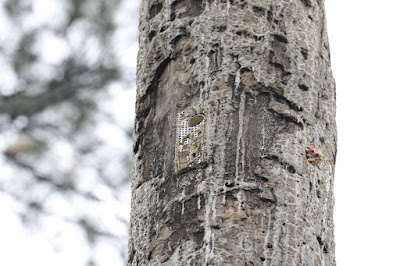Red-cockaded Woodpeckers are unusual in that they are colony nesters. They live in family groups, and cooperatively raise their young. They look for mature pine woodlands with very open understory that is maintained by regular fires. Unfortunately this habitat has become rare due to fire suppression and harvesting of mature pines, so the population of this woodpecker has declined severely in the past several decades.
One interesting behavior of Red-cockaded Woodpeckers is their use of a "sap well" just below their nesting cavity. They poke holes into the tree so that sap flows down below the nest hole. This sap deters snakes and other predators from approaching or entering the nest. I you look closely at the picture below you can see the yellowish sap coating the tree below the nest hole.
Red-cockaded Woodpeckers historically excavated their nesting cavities in large pines with red-heart fungus, a condition which causes a soft core inside of a hard outer shell. As these trees became less common, wildlife biologists came up with a solution to help the woodpeckers out! Cavity boxes inserted into trees in areas where these woodpeckers were known to nest. The availability of cavity trees helped the populations to increase. This particular cavity is no longer being used, but gives an idea of what they look like. These are 30' - 40' up in the tree, so installing them must have been some fun...
Thanks to the efforts of biologists and forest managers, there are several Red-cockaded Woodpecker colonies in our area. We have enjoyed getting out to observe these endangered birds.
Mark






Interesting post. Thanks for sharing all this cool stuff.
ReplyDeleteGreat stuff, Mark.
ReplyDeleteVirginia